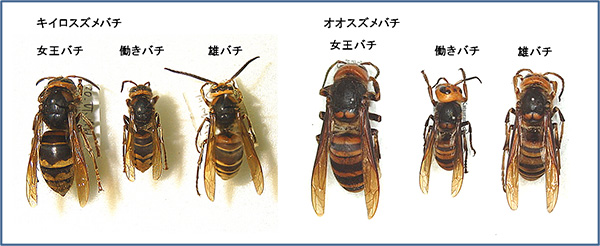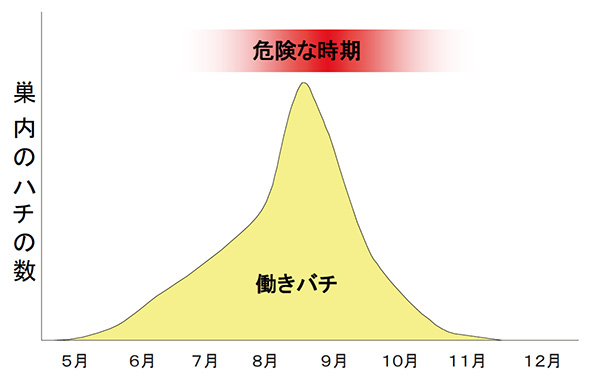 [1]
[1]Japanese giant hornet. Image by Yasunori Koide. [2] GNU Free Documentation License [3].
Japan has a morbid fascination with the Japanese giant hornet (Vespa mandarinia japonica). These giant insects can be found all over Japan, and are especially active in the month of August. Their bites are painful, and a single sting can result in hospitalization. Multiple stings can result in death.
The summer months in Japan sometimes are accompanied by stories of hapless hikers or farmers being swarmed by the giant hornets and stung to death. One blogger [4] has compiled a list of do's and don'ts when encountering giant hornets in Japan. The best advice? Stay away from their nests, especially in August.
There is actually quite a variety of bees, wasps and hornets native to Japan [5]. Hornets are generally referred to as “suzume-bachi” (literally “sparrow-wasp”, likely due to their size) and include the Japanese yellow hornet [6] (Vespa simillima), similar to a yellow jacket in Europe and North America.

Two species of giant hornet in Japan: at left, Japanese yellow hornet (Vespa simillima xanthoptera Cameron) queen with female worker and male drone; at right Japanese giant hornet (Vespa mandarinia japonica) queen with female worker and male drone. Image widely shared on social media. [7]
However, the Japanese giant hornet (“oh-suzume-bachi,” Vespa mandarinia japonica) is a different beast. Related to the “yak-killer” [8] Asian giant hornet, the female workers of the Japanese giant hornet species can grow to 3 centimeters in length, and are large and strong enough to carry the other insects that serve as its prey back to its hive.
The giant hornets fill many Japanese people with a special kind of dreaded wonder.
帰宅してすぐ荷物の整理をして
「アニマルプラネット・スズメバチとの闘い」を視聴(‘ε'*)中学生時代に刺された事がありますが、ハチはトラウマになります。
※文章に様々な生き物が交ざりすみません。スズメバチに気をつけましょう。 pic.twitter.com/xbGp686irl [9]
— 新土裕二(大日本プロレス所属) (@bjw_shindo) August 11, 2016 [10]
As soon as I got home I put away my groceries, and started watching…
“Hornets from Hell” [11] on TV. (‘ε'*)
Ever since I was stung in junior high I've been afraid of bees (I realize I am getting mixed up with bees and hornets). So let's all take the time to remind ourselves to be careful of hornets!
The Japanese giant hornet is most active in August and early September, as thousands of larvae in the nest have matured to become not only new male and female drones ready to take off, mate and find a new colony, but the workers that support and feed them. Anyone out walking in the woods, or even having a barbecue in the park, needs to be careful.

From early August until the beginning of September (horizontal axis) the danger from Japanese giant hornets skyrockets as the number of active wasps (vertical axis) dramatically increases within each nest. Image from grapee [4].
Hornets and humans can live in close proximity. While giant wasps prefer wooded areas for their nests, the Japanese giant hornet can be found in the city.
While not a giant Japanese hornet's nest, this Twitter user, with a photo of a yellow hornet's nest, shows just how easy it can be to come face to face with a less-than-friendly insect:
すげぇ!!!家の窓に蜂の巣が!!!初めて間近でスズメバチ見た!! pic.twitter.com/U2dNf6tV3C [12]
— 増尾勇哉 (@masuiku46) August 17, 2016 [13]
Holy crap! There's a wasp nest on our window! This is the first time I've seen a hornet up close!
Giant Japanese hornets can be very dangerous, and in the summer months it's not uncommon to come across signs and cordoned-off areas warning people away.
赤城山全山冷房ちうの皆さん注意点喚起です!籠山にスズメバチの巣、近づかないようにお願いします。 pic.twitter.com/Rq6ebvX1sZ [14]
— 赤城山頂BBQホール (@kofpop23) August 13, 2016 [15]
Anyone coming to the picnic area, but warned! Don't come near the wasp nest!
And, unfortunately for giant hornets, there is not a “live-and-let-live” mentality in Japan:
地下にスズメバチの巣が出来てて
殺虫剤でなんとかした pic.twitter.com/p6UPag07Of [16]— めるっそ@暁提督 (@merunanoka) August 6, 2016 [17]
I found a hornet's nest underground. I sprayed some bug-killer on it.
Still, Japan, like many other parts of the world [18], has long had a complicated fascination with the giant Japanese hornet.
ひっさびさ♡
はよくーちゃんの妹か弟欲しいんですm(_ _)m
赤ちゃんができて欲しいす♡昆虫館でくーちゃんがスズメバチの模型を操作する写真載っけて明日も暑いけど現場にバイトに頑張りましょか^_^ pic.twitter.com/rREWzZQsWD [19]
— yu_dai (@yudai13028211) August 7, 2016 [20]
This is the first time I've been to the bug museum in a while… Here's a model of a giant Japanese hornet my friend made. It's going to be hot tomorrow so I'll just try to do my best at my part-time job. ^_^
Some people actually stick up for what is really an amazing insect:
危険害虫扱いされ怖がられるオオスズメバチだが、樹液をおいしそうに食べる姿はなんともかわいらしい。食事に夢中なときは少々近寄っても攻撃はしてこない。いいやつだよスズメバチ。巣には近寄らないように注意。(2008年8月撮影) pic.twitter.com/bkhyVL7g2u [21]
— もも (@momodog22) August 11, 2016 [22]
While everyone is afraid of giant hornets, when you see them eating sap from a tree they're actually kind of cute. It's easy to get close to them while they're focusing on eating, and they won't attack. Giant hornets are kind of cool. Just be careful to never go near their nests.
It's also often said that the Japanese giant hornet is considered a delicacy by some people, but it's more likely the insect is considered an exotic food you might only ever try on a dare.
未来ちゃんがお土産にプレゼントしてくれたオオスズメバチが2匹入った(しかもはちみつ入りの)焼酎
それを1匹とりだしてロシアンたこ焼きに…
蜂は糖尿病に効くらしいロシアンたこ焼き5回やったうち4回がしおみさんに当たりました💦 pic.twitter.com/pVre3dixm2 [23]
— 松野井 雅 (@MIYAVI_MATSUNOI) August 12, 2016 [24]
Look at this delicious souvenir I got: a bottle of shochu (a distilled spirit similar to vodka) with two giant hornets inside (the shochu was distilled from honey). We then dared each other to eat it. Apparently giant hornets are an effective medicine against diabetes??? […]
今回の虫食。蚕のかきたま汁、クマゼミだし巻き、スズメバチのかき揚げ。 pic.twitter.com/3feNLsshBg [25]
— 伊東憲二 (@ken2_g) August 7, 2016 [26]
Today's edible insects: silkworm soup, cicada rolls, and deep-fried giant hornets.
Others have found beauty in the hornet, such as this potter who specializes in some pretty amazing creations [27] inspired by insects and other animals.
こんな立派な巣を作られたのも、スズメバチのマグカップとか作っているご利益かな? pic.twitter.com/hgCFYdha4q [28]
— 工房うむき@進化学会8/25〜28 (@kobo_umuki) August 11, 2016 [29]
I wonder if anyone will be interested in buying this hornet's nest (with giant hornet) ceramic mug?